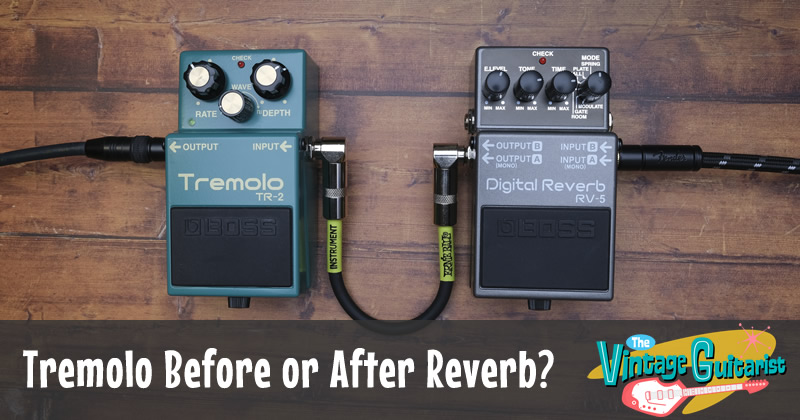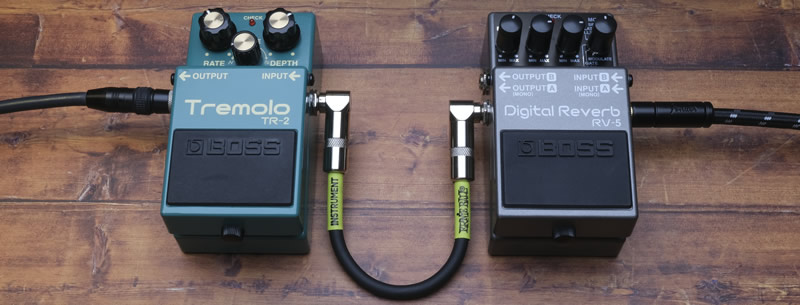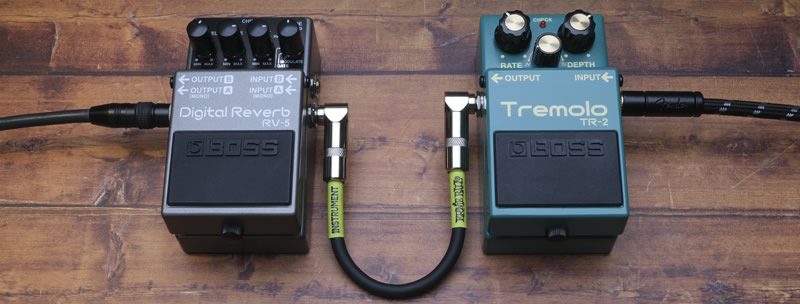Tremolo is literally the oldest effect to have been produced and has been popular with guitar players ever since. The pulsing sound is created by turning the volume up and down at a steady rate producing a distinctive pulsating effect.
It can produce some classic guitar sounds especially when combined with reverb. From 60s surf music to 1980s pop – it’s an amazing sound! But were in the signal chain should you place the tremolo pedal? Before or after reverb? While it might well seem like a minor detail it can produce very different results.

From eerie and haunting to underwater sounds these two effects make a great combination and really can capture the vintage vibe.
Traditionally the rule is modulation effects go before reverb but tremolo is different. You’ll find a split in people’s opinions but let’s look at the basic principles.
Reverb First
If you place tremolo AFTER reverb, you’ll make the reverb choppy – doesn’t mean that’s bad though. The sound is then more pronounced and stands out as the reverb will be affected by the volume fluctuations of the tremolo.

Placing tremolo at the end of the chain will always produce the most pronounced effect. It’s exactly how is
Tremolo First
If you put tremolo BEFORE reverb and you’ll get a more subtle sound as the reverb trails (tails) don’t get cut up. The reverb will be much more consistent and unaffected by the volume fluctuations of the tremolo giving a smoother sound.

Generally, we look at placing ambient effects like delay and reverb at the very end of the chain. Tremolo is one of those effects that can break the rules. OK, breaking the rules was a bit dramatic. Guidelines is a better word. Experimentation is important and there really isn’t any “wrong way” to position pedals and it’s all down to personal preference.
How Do Classic Fender Amps Do It?
Traditional Fender circuitry (think of blackface amps like the Deluxe Reverb) has the reverb running into tremolo (or Vibrato as they call it on the amp – but that’s another story).
The reality is that is had to happen this way as the effect was created in the power stage of the amplifier. It’s how amp tremolo has been done in valve amplifiers since Fender released the Tremolux back in 1955.
So, this choppy tremolo effect is how many people are used to hearing it on classic recordings etc.
How Can I Switch the Pedal Order for Different Songs?
If you find that on most songs you have a strong preference but there is a song you want it the other way around then it can be problematic because you’ll have to swap the order of the pedals. This is far from ideal in a live situation. The solution could well be to have two tremolo pedals with one connected on either side of the reverb pedal.
However, there is another answer to this problem – combined tremolo and reverb pedals such as the Fender Tre-Verb allow you to swap the order of the tremolo and reverb at the flick of a switch.
Strymon’s Flint Pedal allows you to do this just by pushing both footswitches simultaneously. Using a combined tremolo and reverb pedal is a great solution without using too much valuable pedalboard real estate.
The other thing to try is to put it before anything else in your pedal chain. Put it before any overdrive or distortion pedals and you’ll have a different sound again.
Conclusion
Although the traditional placement for a tremolo pedal is last in the effects chain, I recommend you experiment with placement on your board and get used to how it changes the sound. There is certainly no wrong or right way, let your ears be the judge of what is best for your setup.
